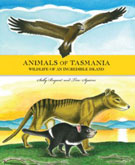
This beautiful book is a collaboration between two people who are passionate about the fauna of Tasmania. Sally Bryant is a zoologist who for many years worked for the Tasmanian Government running the Tasmanian Threatened Species Unit. Tim Squires is an artist who, while studying at the University of Tasmania Art School, developed a strong interest in nineteenth-century scientific illustration and natural history art in general.
This unusual collaboration between artist and biologist has resulted in a remarkable publication.
The book begins with a section titled 'How it all began'. This details how Tasmania came to be an island with so many unique species. It explains the convoluted processes from the formation of Gondwana and the arrival of the marsupial fauna from South America, to the isolation of Tasmania at the end of the last ice age, the intimate relationship of the Aboriginal people to the land and its fauna, and the arrival of Europeans in 1803. Although written from a scholarly standpoint, it is well written and accessible. The book includes maps, a table, and some lovely images of fauna accompanied by quotations, all of which are hand drawn. I would be hard pressed to think of a more eloquent and easily understandable explanation of the complicated processes that resulted in the unique flora and fauna assemblages that we see today.
This introductory section is followed by 29 species accounts, written by Bryant and accompanied by Squires' sketches and drawings. All the major species are represented. It is refreshing to see some of the less familiar species, such as the Tasmanian masked owl, the Tasmanian native-hen and the Pedra Branca skink, as well as some recently extinct species. Books on Tasmanian fauna usually include an account of the thylacine and sometimes the Tasmanian emu, two well-known extinct species that have achieved iconic status in recent years. Less well known are the two Macquarie Island extinctions: the Macquarie Island rail and the Macquarie Island parakeet. Both are included in this book.
Each species account is accompanied by one or more of Squires' artworks. Sometimes, these are completed works, such as the detailed pencil drawing of the head and skull of the Tasmanian devil, or the pen-and-ink depiction of the Tasmanian native-hen. Others are presented as artist working sketches, complete with colour references and notes. These are among the most interesting images. They frequently depict the animal posed in a typical way that shows its morphology, and are surrounded by sketches indicating aspects of the animal's behaviour and habits. My favourite image of this style would have to be that of the Eastern quoll, comprising 11 separate drawings, which together give an impression of the character and nature of this remarkable little carnivorous marsupial.
I have one small quibble. The species account of the thylacine refers to the last animal in the Hobart Zoo being called Benjamin. It is now known that the last zoo animal was a female, and that none of the zoo thylacines were ever given names. A minor point, but an example of how myth can become fact when often enough repeated.
Animals of Tasmania is for a general audience and has appeal for all ages. At one level, it is an ideal souvenir for visitors wanting a snapshot of what is most special about Tasmania. At another, it is a well-researched and reliable study that will be useful for educators and students of natural history. It is a valuable addition to the literature on Tasmanian fauna.
Kathryn Medlock is senior curator of vertebrate zoology, Tasmanian Museum and Art Gallery, an associate of the National Museum of Australia's Centre for Historical Research and a PhD candidate at The Australian National University.
